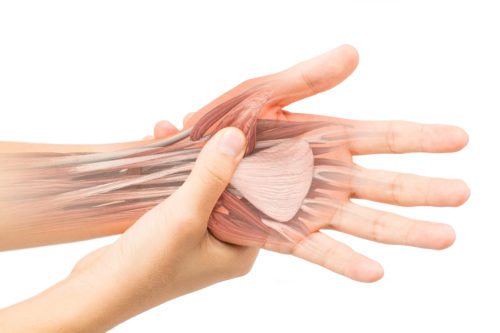
If you are like millions of other Americans, you are constantly on your computer or cell phone. But when you lead a technology-based lifestyle, you may notice some side effects. One of the most common things people notice is a slight tingling or numbness accompanied by a piercing pain in their hands and wrist. This pain is quick and can be thought of as a cramp or muscle spasm, but it could be something more serious like carpal tunnel syndrome. But what is carpal tunnel syndrome and how can physical therapy help it? Let’s take a look!
What is CTS?
Carpel tunnel syndrome (CTS) is one of the most common nerve disorders. The carpal tunnel is located at the wrist on the palm side of the hand and is just beneath the skin. This syndrome occurs when the median nerve, which runs from the forearm into the palm of the hand, becomes pressed of squeezed at the wrist. The median nerve controls the sensations from the palm of the thumb and fingers (excluding the pinky) as well as impulses in the small muscles of the hand that allow the fingers and thumb to move. The name “carpal tunnel” refers to the narrow passage of ligaments and bones at the base of the hand that houses the median nerve and tendons. One out of 20 Americans suffer from CTS and experience symptoms of tingling, burning, “pins and needles,” and numbness on the palm side of their hand and fingers. You may also notice weakness in the hand which causes you to drop objects you are gripping.
Treatments
When seeing an orthopedic doctor, your condition will be evaluated through several tests. For non-serious conditions, you will be prescribed acetaminophen or an anti-inflammatory drug to help reduce the swelling in the ligaments and nerves. A splint could also help reduce the swelling and decrease the pressure on the nerve. Another option is a cortisone injection that is administered every few months. The final step for severe cases is surgery. Although it can be performed as an open surgery, it is most often performed as an outpatient endoscopic procedure. A small incision is made at the wrist in order to remove the inflammation building in your nerve.
Physical Therapy
If your evaluation confirms the early stages of Carpal Tunnel Syndrome, physical therapy (PT) can still help. PT can help reduce the symptoms of CTS and will get you back to your normal life as soon as possible. Your physical therapy will include education about wrist positioning, proper posture, using tools, as well as stretches to perform at work or during your daily routines. Your Life Fitness PT therapist will teach you exercises to increase strength and flexibility in the muscles of your hand, fingers, and forearm. For post-surgical PT, your therapist will teach you exercises to improve your strength, flexibility, and function of the wrist/hand muscles. They will also help with scar management to keep the skin looking nice and educate you on posture and wrist position to avoid recompression of the carpal tunnel during activities.
Your Life Fitness Physical Therapist can help you regain the feeling in your hands in just a few visits and you will be feeling better than before. For more information on physical therapy, call your Life Fitness PT location today!
Contact Us to Learn More about Life Fitness PT!
If you’d like to schedule an appointment to help with your aches and pains, call Life Fitness Physical Therapy today at 410-368-1026, or find a convenient location. If you’d like more information about what to expect on your first visit with us, please check out our FAQ page.
